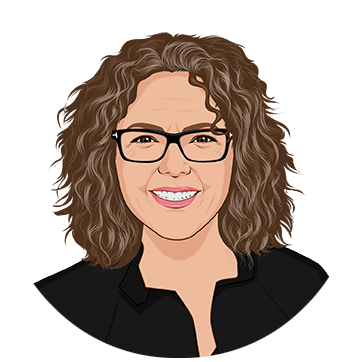Learning why we DID NOT get the job can be the most value-packed free resource, and I’m surprised by how available it is to us if we ask. With a bit of timely follow-through, we could potentially receive the clear strategic feedback every business needs.
Clients
How To Show Clients They Can Trust Us
Clients need to trust us if we want to create open and honest communication. One way to keep it honest is to change the bidding categories they requested on the 1st revision instead of adjusting other costs/conditions they may not notice.
Communicate WIth Your Client To Aid In Negotiation
NEGOTIATING TIP 101:
Get the most information in the shortest amount of time with a good old-fashioned client Phone Call. Use the phone time wisely to get those “awkward to ask” questions about budget, first choice, competition, and lowest bid topics. It’s that one-to-one camaraderie with off-the-cuff, less self-aware personalized touch moments.
Negotiating over the phone is more effective than doing it in person or via Zoom. In our experience, more information is shared once people warm up and get to know each other on the phone. We’re unsure why this is the case, but perhaps people may be less aware of themselves on the phone, making them more likely to share information. We recommend trying an old-fashioned chat for negotiations.
Following Up With Potential Clients Who Open Your Newsletter

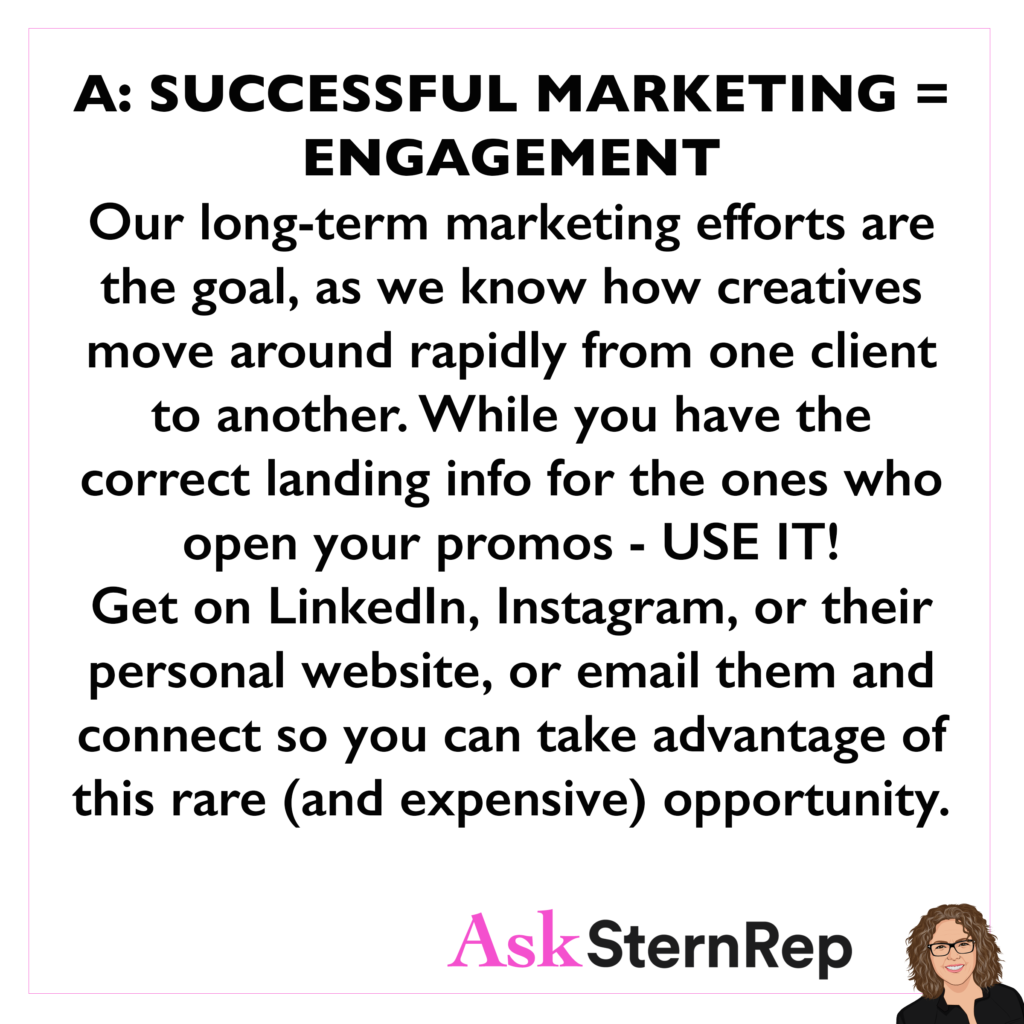
Q:
How do I follow up with someone who appears to have opened my newsletter repeatedly, but I don’t have any relationship with them, and their agency doesn’t appear to do work that aligns with mine? This makes it hard even to know what to send as a follow-up. It’s hard to know how to open the conversation without the incredibly creepy “I see you’ve been opening my newsletter a lot this week.”
A:
SUCCESSFUL MARKETING = ENGAGEMENT
Our long-term marketing efforts are the goal, as we know how creatives move around rapidly from one client to another. While you have the correct landing info for the ones who open your promos – USE IT! Get on LinkedIn, Instagram, or their personal website, or email them and connect so you can take advantage of this rare (and expensive) opportunity.
Who To Connect With When Approaching A Big Ad Agency


Q:
When approaching a big ad agency, who should I connect with? I usually hit up a mid-level art director, but should I be approaching producers? I tend to send expensive DM pieces, so I can’t ship to everyone!
A:
The decision-makers at big ad agencies include the Creative Director, Art Director, and Producers. All three are involved with different roles, but the AD usually chooses which photographer will be the “recommend” to the client for the final decision. My method is to contact all of them and see who responds, giving me better odds of a more personalized, well-received marketing piece.
Do You Turn Jobs Away Because of Low Budgets?
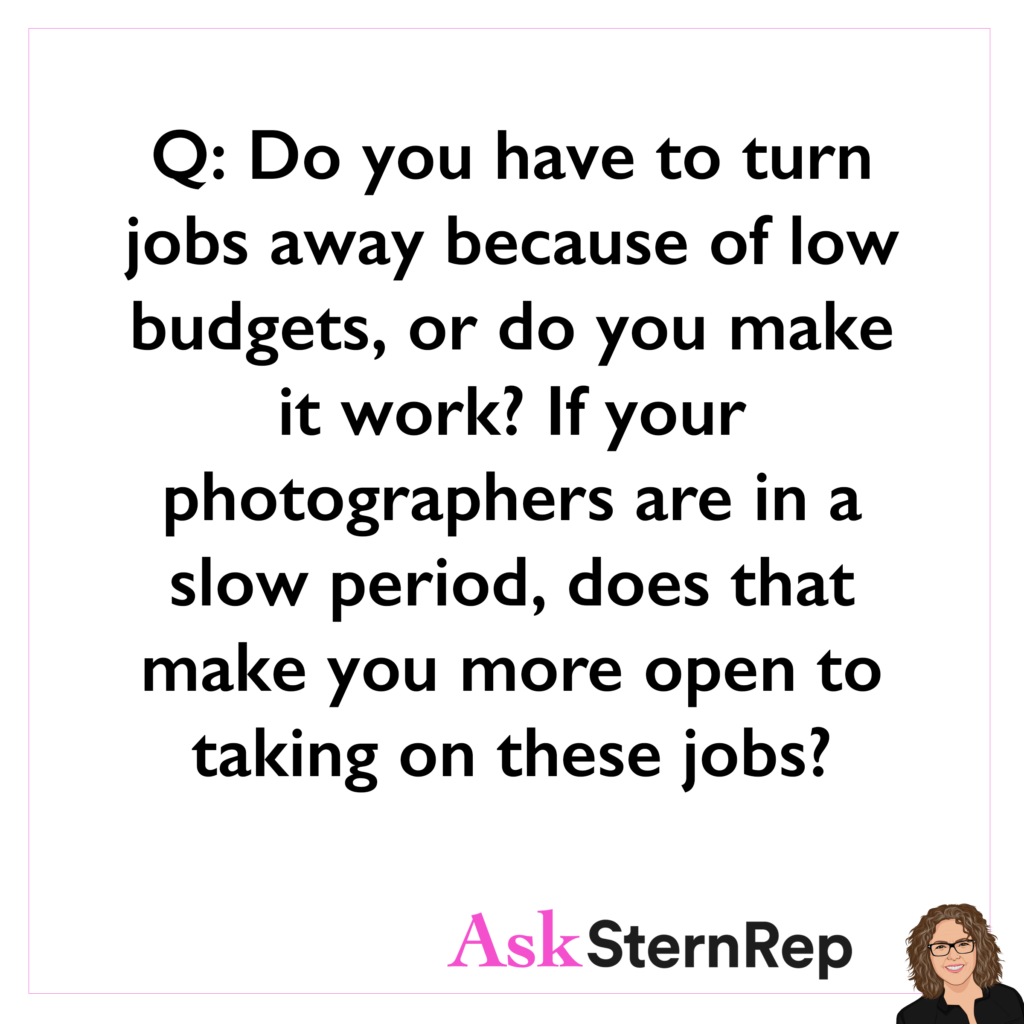
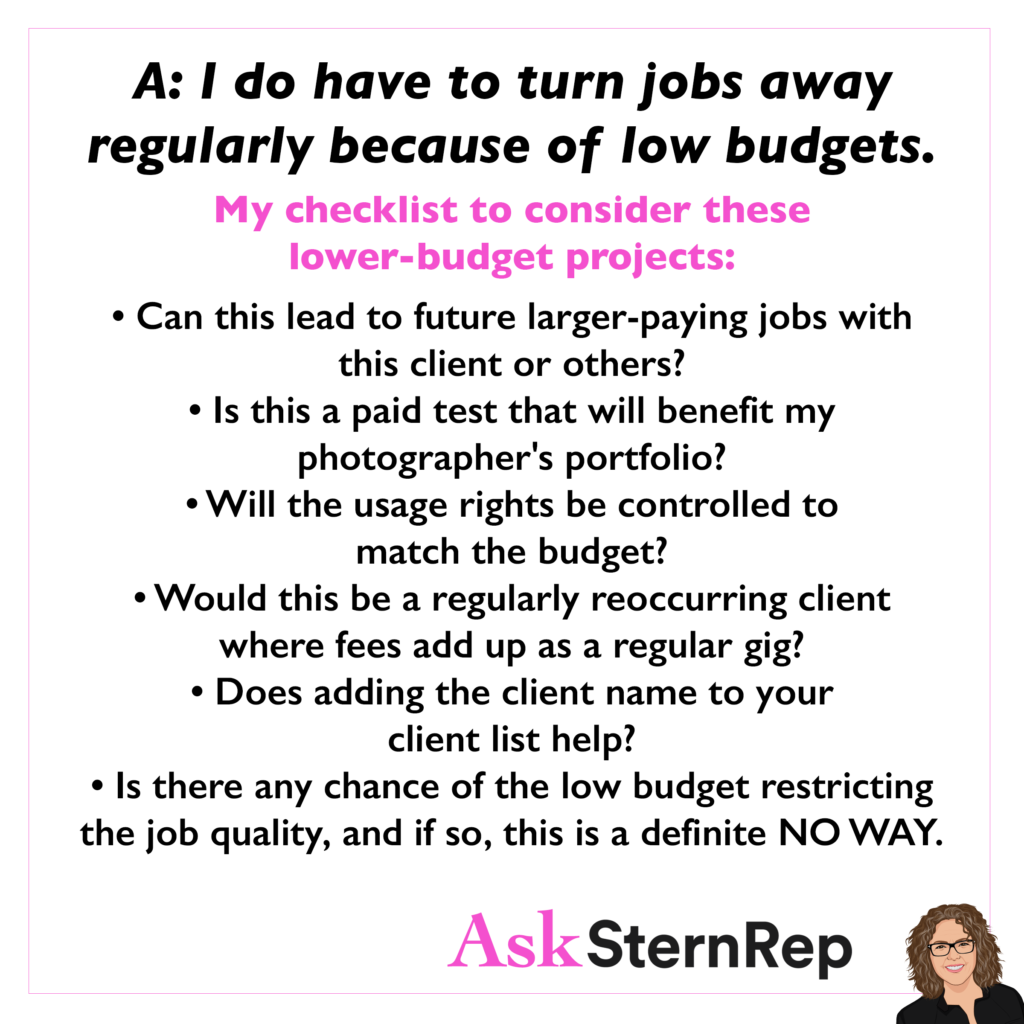
Q:
Do you have to turn jobs away because of low budgets, or do you make it work? If you photographers are in a slow period, does that make you more open to taking on these jobs?
A:
I do have to turn jobs away regularly because of low budgets.
My checklist to consider these lower-budget projects:
- Can this lead to future larger-paying jobs with this client or others?
- Is this a paid test that will benefit my photographer’s portfolio?
- Will the usage rights be controlled to match the budget?
- Would this be a regularly reoccurring client where fees add up as a regular gig?
- Does adding the client name to your client list help?
- Is there any chance of the low budget restricting the job quality, and if so, this is a definite NO WAY.
Will It Help To Lower Prices To Bring In More Clients?

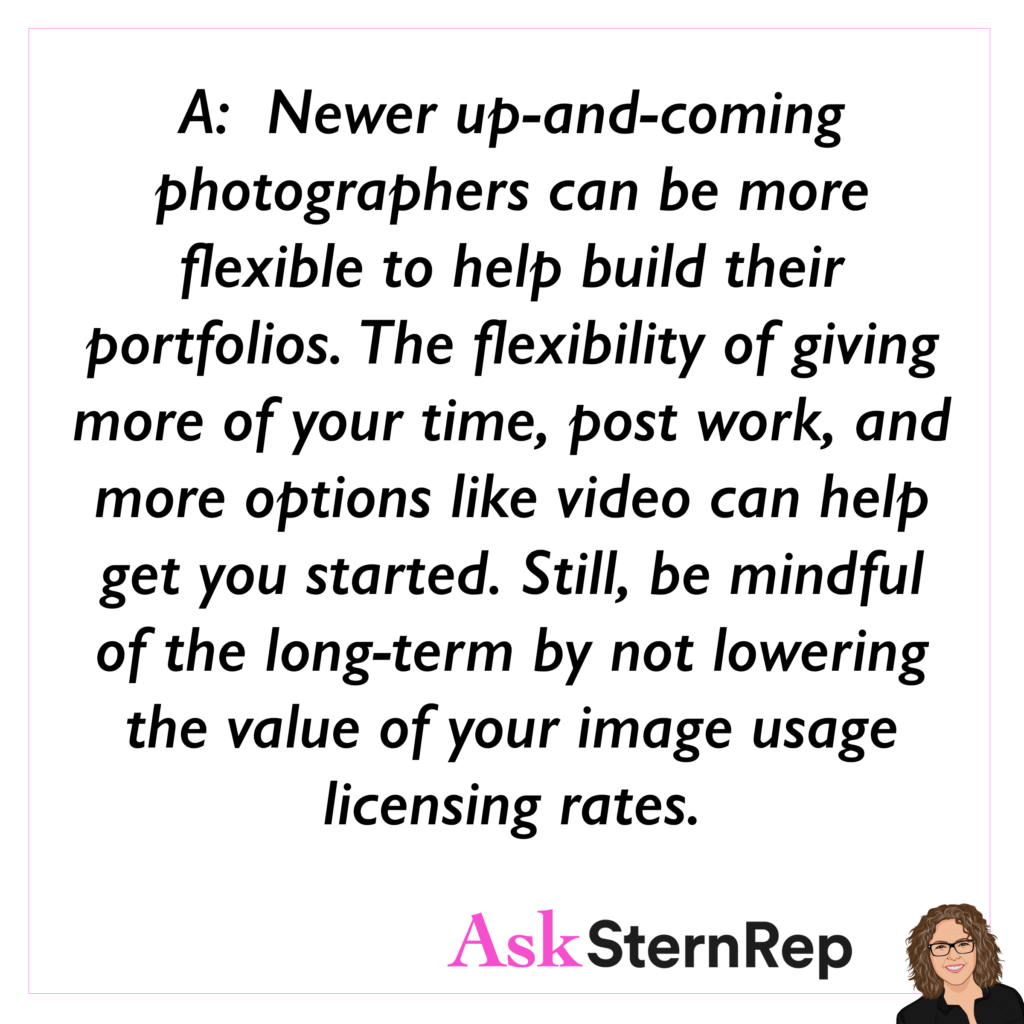
Q:
How do I get hired as I am just starting with my photo business? Will it help if I lower my prices to bring in more clients?
A:
Newer up-and-coming photographers can be more flexible to help build their portfolios. The flexibility of giving more of your time, post work, and more options like video can help get you started. Still, be mindful of the long-term by not lowering the value of your image usage licensing rate.
Learn More About the Budget Before Making Your Estimate
STOP WASTING TIME DOING ESTIMATES YOU DON’T NEED TO DO!
It’s wild how many bidding requests we get from random clients that don’t even pertain to us. We must find out the budget before we waste our time. Even though that is the exact info clients usually refuse to give us, we have to push through by asking if their budget is between certain amounts. That type of “yes/no” question usually sparks a client to respond if it’s over what they have available to spend. Give it a try.
Do not waste your time doing estimates you don’t need to do. Photographers should avoid wasting time on estimates and calculations for clients who may not have the budget for their services. Instead, photographers should ask for a budget range upfront, so they can quickly determine if the client’s budget aligns with their own rates. By doing this, photographers can avoid spending time on clients who cannot afford their services and focus on those who can. Self-employed photographers need to be mindful of their time and avoid wasting it on unproductive activities.
Reaching Out To Clients To Create Their Content
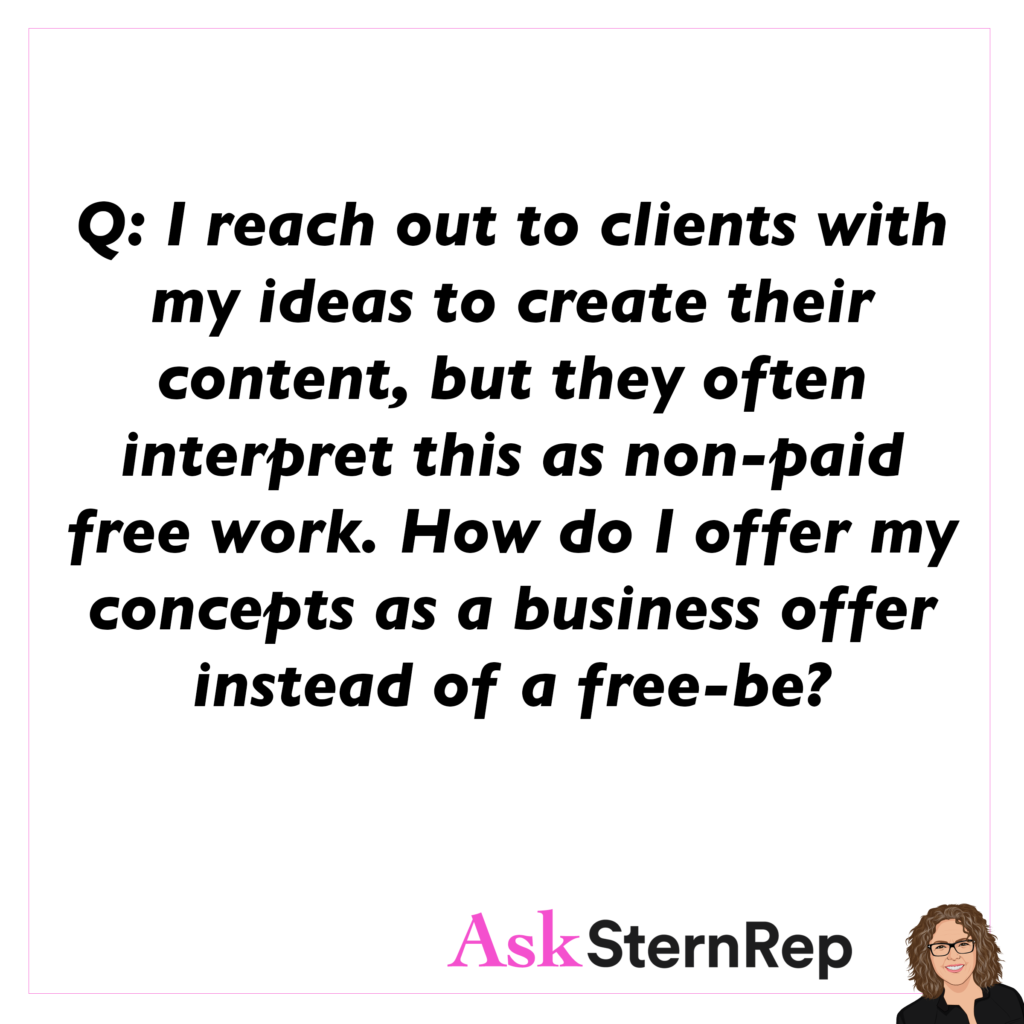

Q:
I reach out to clients with my ideas to create their content, but they often interpret this as non-paid free work. How do I offer my concepts as a business offer instead of a free-be?
A:
Two ways to handle this:
- Include pricing (or a pricing range) in your request to put it on the table without potential confusion.
- Go for the clients who always pay for content instead of those using unpaid images.
Connecting With A Client Is The Best Sales Pitch
The BEST SALES PITCH I can recommend is to humanize what we call “sales” by listening. So simple and yet the most powerful way to negotiate, stay in front of clients, or sell ourselves. Take the first hello moment on a Zoom call, notice something about them, and ask a question. Connect by listening to get your foot in the doors.
The best sales pitch is to humanize the clients and be real, honest, and listen to them. Humanizing the clients means to understand them, empathize with them, and treat them as individuals, not just as potential customers. Being real and honest means to not make false promises or exaggerate the product’s capabilities. Listening to the clients is crucial as people want to be heard and understood. It doesn’t take very long to notice something about them and ask them a question, which can help build a rapport and establish a relationship. The best sales pitch is to recommend the product or service that meets the client’s needs and wants, not just to sell something for the sake of making a sale. The key is to build trust and credibility with the clients, which can lead to long-term relationships and referrals.
